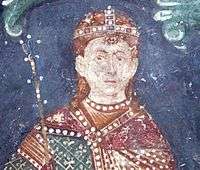Stefan Konstantin
| Stefan Konstantin | |
|---|---|
|
Gračanica fresco | |
| King of Serbia | |
| Reign | 1321–22 |
| Coronation | after 29 October 1321 |
| Predecessor | Stephen Uroš II Milutin |
| Successor | Stephen Uroš III |
| Born | ca. 1282 |
| Died |
ca. 1322 Zeta |
| Issue | Stefan Vasoje |
| Dynasty |
Nemanjić |
| Father | Stephen Uroš II Milutin |
| Mother | Ana Terter |
| Religion | Eastern Orthodox Christianity |
Stefan Konstantin (Serbian Cyrillic: Стефан Константин; ca. 1282–1322) was the King of the Serbian Kingdom in ca. 1321–22. The son of Stefan Milutin, he initially held the appanage of Zeta (with Zahumlje and Travunia), and was the heir to the Serbian thone after his father had exiled his revolting brother Stefan Dečanski. After his father's death, a throne struggle broke out between Konstantin, Dečanski and their cousin Vladislav II. He was killed by his younger brother in ca. 1322, who went on to defeat Vladislav and gained the Serbian throne.
Life
Early life
His father was Stefan Uroš II Milutin of Serbia.[1] It is believed that Konstantin's mother was either Helena Doukaina, the daughter of John I Doukas of Thessaly, or Elizabeth of Hungary.
As prince, he held the župa (county) of Nevesinje between 1303–06.[2][3]
Prince of Zeta
After the failed rebellion by his younger brother Stephen Uroš III (1314), and the death of his uncle Stefan Dragutin in 1316, Konstantin was given the title Young King, and ruled Zeta; as de facto intended heir, though his father had not officially proclaimed him as such in the state assembly. Stephen Uroš III had been exiled to Constantinople, but had been allowed to return in 1321 following talks between the Archbishop and King Milutin.
His father's endowment of the cathedral of Bari included a silver altar with Konstantin's inscripted name.[4]
King
His father died on 29 October 1321. Konstantin was proclaimed King in Zeta, and started to issue coins from Skadar, which depicted him sitting on a throne, including a Latin inscription.[5] Venetian chronicles mention him as "king" (rex); if Konstantin indeed signed his coinage in Skadar with that title, it shows which plans he had.[6] At the same time, his brother Stefan Uroš III and cousin Vladislav, Dragutin's son, claimed the throne.
Details of the throne struggle does not exist, though it is known it resulted in an armed conflict. The Church supported Uroš III, and on 6 January 1322, crowned him King of Serbia, after which, according to the hagiography by Grigorije Camblak, Konstantin was offered to "accept another dignified Empire, as the second son". He declined, as he trusted the strength of his army, in which there were also foreign mercenaries. Konstantin's army was defeated, and part of the troops switched to Uroš III's side. Konstantin was most likely captured or killed while retreating. Uroš III went on to defeat Vladislav, the ruler of the Kingdom of Syrmia, in late 1324; and unified the Serbian crown.
According to A. Ivić, he was anti-king sometime between 1321 and 1323, when he was killed.[7]
According to Serbian epic poetry, Konstantin was supported by the Bulgarians; Vladislav was a Hungarian candidate; and Stefan Uroš III was supported by the Byzantines. Uroš III bribed Konstantin's army, which crucified him, sawed him in half, and tossed him into the river.[8]
Some chronicles have recorded stories of his alleged brutal execution, with the Dominican Pseudo-Brocard (1332) stated that Uroš III ordered him nailed to a tree, after which he was cut in half, while Mavro Orbin (1601) said that this was done by Vladislav, who had captured him. There also exist a legend that his severed head was emptied and used as a cup from which Uroš III drank wine.
Legacy
Konstantine provided long lists of Byzantine, Bulgarian and Serbian monarchs from the 11th century onwards, as his father had done before him.[9] After Konstantin's death, his body was transferred and buried in the Church of St. Nicholas, Zvečan, in Kosovo, an endowment of the Nemanjić dynasty.
According to Vasojevići folklore, the tribe was founded by Vaso, great-grandson of Stefan Konstantin.[10] The Vasojevići tribe, and Vaso, the founder, is mentioned for the first time in a document found in an archive of Dubrovnik (Ragusa), dated 1444.[11]
| Regnal titles | ||
|---|---|---|
| Preceded by Stefan Dečanski |
Prince of Zeta 1314-1322 |
Succeeded by Stefan Dušan |
| Preceded by Stefan Milutin |
King of Serbia 1321-1322 |
Succeeded by Stefan Dečanski |
References
- ↑ Dejan Nikolić (1996). Svi vladari Srbije. Narodna biblioteka "Resavska škola". p. 76.
- ↑ Ljubo Mihić (1975). Ljubinje sa okolinom. Dragan Srnic. p. 117.
- ↑ Obrad Mićov Samardžić; Mirjana Samardžić; Saša Samardžić; Aleksandra Samardžić (2006). Svadbe i pogrebni običaji pravoslavnih u Nevesinju. Čigoja štampa. p. 11.
први познати господар жупе Невесиње спомиње се Константин Немањић (1303-1306)
- ↑ Branislav Todić (1999). Serbian medieval painting: the age of King Milutin. Draganić. p. 49.
- ↑ Dejan Nikolić (1996). Svi vladari Srbije. Narodna biblioteka "Resavska škola". p. 98.
- ↑ Ivan Božić (1979). Nemirno Pomorje XV veka. Srpska književna zadruga. p. 205.
- ↑ Aleksa Ivić (1923). Rodoslovne tablice srpskih dinastija i vlastele.
- ↑ Vuk Stefanović Karadžić; Milne Holton; Vasa D. Mihailovich (1997). Songs of the Serbian people: from the collections of Vuk Karadžić. University of Pittsburgh Press. ISBN 978-0-8229-3952-8.
- ↑ Macedonian Studies. Research Programme for Macedonian Studies. 1988. p. 64.
- ↑ Djukic. "Vasojevići" (PDF). Archived from the original (PDF) on April 25, 2012.
- ↑ R-J. V. Vesović, 1935, "Pleme Vasojevići", Državna Štampa u Sarajevu, Sarajevo
Further reading
- Марица Маловић-Ђукић (1985). "Константин, син краља Милутина". Историјски записи. 3–4: 69–75.
